
A frog is any member of a diverse and largely carnivorous group of short-bodied, tailless amphibians composing the order Anura. The oldest fossil "proto-frog" Triadobatrachus is known from the Early Triassic of Madagascar, but molecular clock dating suggests their split from other amphibians may extend further back to the Permian, 265 million years ago. Frogs are widely distributed, ranging from the tropics to subarctic regions, but the greatest concentration of species diversity is in tropical rainforest. Frogs account for around 88% of extant amphibian species. They are also one of the five most diverse vertebrate orders. Warty frog species tend to be called toads, but the distinction between frogs and toads is informal, not from taxonomy or evolutionary history.

Lithobates sylvaticus or Rana sylvatica, commonly known as the wood frog, is a frog species that has a broad distribution over North America, extending from the boreal forest of the north to the southern Appalachians, with several notable disjunct populations including lowland eastern North Carolina. The wood frog has garnered attention from biologists because of its freeze tolerance, relatively great degree of terrestrialism, interesting habitat associations, and relatively long-range movements.

The European spadefoot toads are a family of frogs, the Pelobatidae, with only one extant genus Pelobates, containing six species. They are native to Europe, the Mediterranean, northwestern Africa, and western Asia.
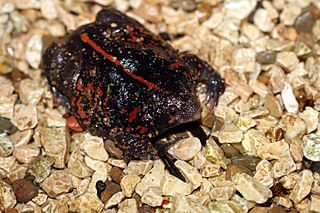
The Mexican burrowing toad is the single living representative of the family Rhinophrynidae. It is a unique species in its taxonomy and morphology, with special adaptations to assist them in digging burrows where they spend most of their time. These adaptations include a small pointed snout and face, keratinized structures and a lack of webbing on front limbs, and specialized tongue morphology to assist in feeding on ants and termites underground. The body is nearly equal in width and length. It is a dark brown to black color with a red-orange stripe on its back along with splotches of color on its body. The generic name Rhinophrynus means 'nose-toad', from rhino- (ῥῑνο-), the combining form of the Ancient Greek rhis and phrunē.

The Scaphiopodidae are a family of American spadefoot toads, which are native to North America. The family is small, comprising only seven different species.

The American toad is a common species of toad found throughout Canada and the eastern United States. It is divided into three subspecies: the eastern American toad, the dwarf American toad and the rare Hudson Bay toad. Recent taxonomic treatments place this species in the genus Anaxyrus instead of Bufo.

Spea hammondii, also known as the western spadefoot, western spadefoot toad, Hammond's spadefoot, or Hammond's spadefoot toad, is a species of amphibian in the family Scaphiopodidae. It is found in western California (USA) and northwestern Baja California (Mexico). The specific name hammondii is in honor of physician and naturalist William Alexander Hammond.

Scaphiopus is a genus of North American amphibian commonly referred to as the North American spadefoots, southern spadefoots, or eastern spadefoot toads. They differ greatly from true toads by having eyes with vertical pupils, no parotoid gland, and relatively smooth skin. Their most distinctive feature is a spade-like projection on their hind feet, from which their common name is derived. This projection enables spadefoot toads to dig in loose soils with ease. Its scientific name means ‘spade-foot’ as well, from the Ancient Greek skaphís and pous.

The eastern hog-nosed snake, is a species of mildly venomous rear-fanged snake in the family Colubridae. The species is endemic to North America. There are no subspecies that are recognized as being valid. This species prefers habitats with sandy soils and a combination of grass fields and forest edges. They come in many different colorations and have the identifiable upturned "snout". They can be found in captivity but are a more difficult species to keep due to a specialized diet of toads.

Spea is a genus of North American amphibian commonly referred to as the western spadefoot toads. They differ greatly from true toads by having eyes with vertical pupils, no parotoid glands, and relatively smooth skin. Their most distinctive feature is a spade-like projection on their hind feet, from which their common name is derived. This projection enables spadefoot toads to dig in loose soils with ease. Its name is from the Ancient Greek speos

The Texas toad is a species of medium-sized toad that occurs in the southern United States and northern Mexico. It breeds in temporary water pools after heavy rains.

Couch's spadefoot toad or Couch's spadefoot is a species of North American spadefoot toad. The specific epithet couchii is in honor of American naturalist Darius Nash Couch, who collected the first specimen while on a personal expedition to northern Mexico to collect plant, mineral, and animal specimens for the Smithsonian Institution.

Hurter's spadefoot toad or Hurter's spadefoot is a species of American spadefoot toad found in the south central United States ; its range might extend to the adjacent northern Mexico. It was once classified as a subspecies of the eastern spadefoot toad, but it has been granted its own species status. The specific name hurterii is in honor of the Swiss-American naturalist and curator of the St. Louis Academy of Sciences, Julius Hurter.

Gastrophryne carolinensis, the eastern narrow-mouthed toad, is a species of microhylid frog. It is a relatively small, toad-like amphibian found in damp, shady habitats. The species is highly fossorial, and feeds primarily on ants. These North American microhylids are distinguished from true toads, and other anurans by their moist, smooth skin, their lack of eardrums or tympana, their distinguishable squat body shape, and the unique fold of skin superior to their eyes. It is found in the United States, from southern Maryland to the Florida Keys, west to Missouri and Texas. While not a true toad, it is so called because it is terrestrial.
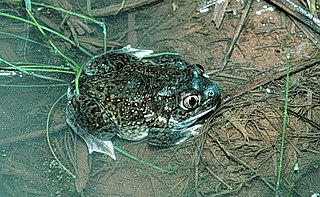
The plains spadefoot toad is a species of American spadefoot toad which ranges from southwestern Canada, throughout the Great Plains of the western United States, and into northern Mexico. Like other species of spadefoot toads, they get their name from a spade-like projection on their hind legs which allows them to dig into sandy soils. Their name, in part, comes from their keratinized metatarsals, which are wide instead of "sickle shaped". The species name translates as buzzing leaf shaped. This refers to the species' distinguishing features; its buzzing mating call, and its leaf-shaped digging metatarsals. It was first described by Cope in 1863.
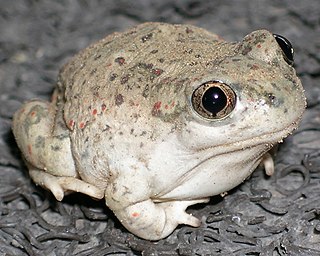
The New Mexico spadefoot toad is a species of American spadefoot toad found in the southwestern United States and Mexico. Like other species of spadefoot toad, they get their name from a distinctive spade-like projections on their hind legs, which enable them to dig in sandy soils. Spea multiplicata can be identified by its wedge-shaped spade. Some sources also refer to the species as the Mexican spadefoot toad, desert spadefoot toad or southern spadefoot toad.

The Yosemite toad is a species of true toad in the family Bufonidae. Endemic to the Sierra Nevada of California, the species ranges from the Alpine County to Fresno County. Yosemite toads are only found in the montane to subalpine elevational zone of 1,950–3,445 m (6,398–11,302 ft) asl. The Yosemite toad is similar to the nearby western toad, but in many ways adapted to a high elevation lifestyle. It was initially described during the Grinnell Survey of California, by an undergraduate student of Joseph Grinnell named Charles Camp.

The Great Basin spadefoot is an amphibian in the family Scaphiopodidae. It is 3.8 to 6.3 centimetres long and is usually colored gray, olive or brown. Great Basin spadefoot toads have adapted to life in dry habitats. They use the hard, keratinized spade on each foot to dig a burrow, where they spend long periods during cold and dry weather. They are opportunistic hunters and will eat anything they can subdue. While their tadpoles have numerous predators, adults are able to produce skin secretions that deter enemies.
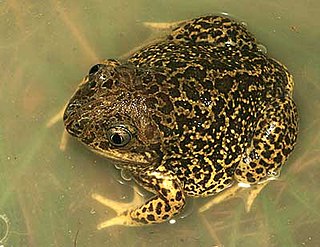
Pelobates cultripes is a toad species in the family Pelobatidae. It is known under many different common names, including the western spadefoot, Iberian spadefoot toad, Spanish spadefoot toad, and Wagler's spadefoot toad. It is found in most of the Iberian Peninsula with isolated populations southern and western France.
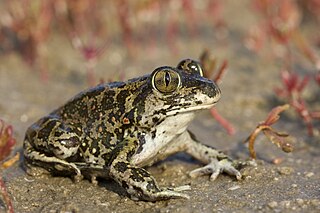
Pelobates syriacus, the eastern spadefoot or Syrian spadefoot, is a species of toad in the family Pelobatidae, native to an area extending from Eastern Europe to Western Asia.



















